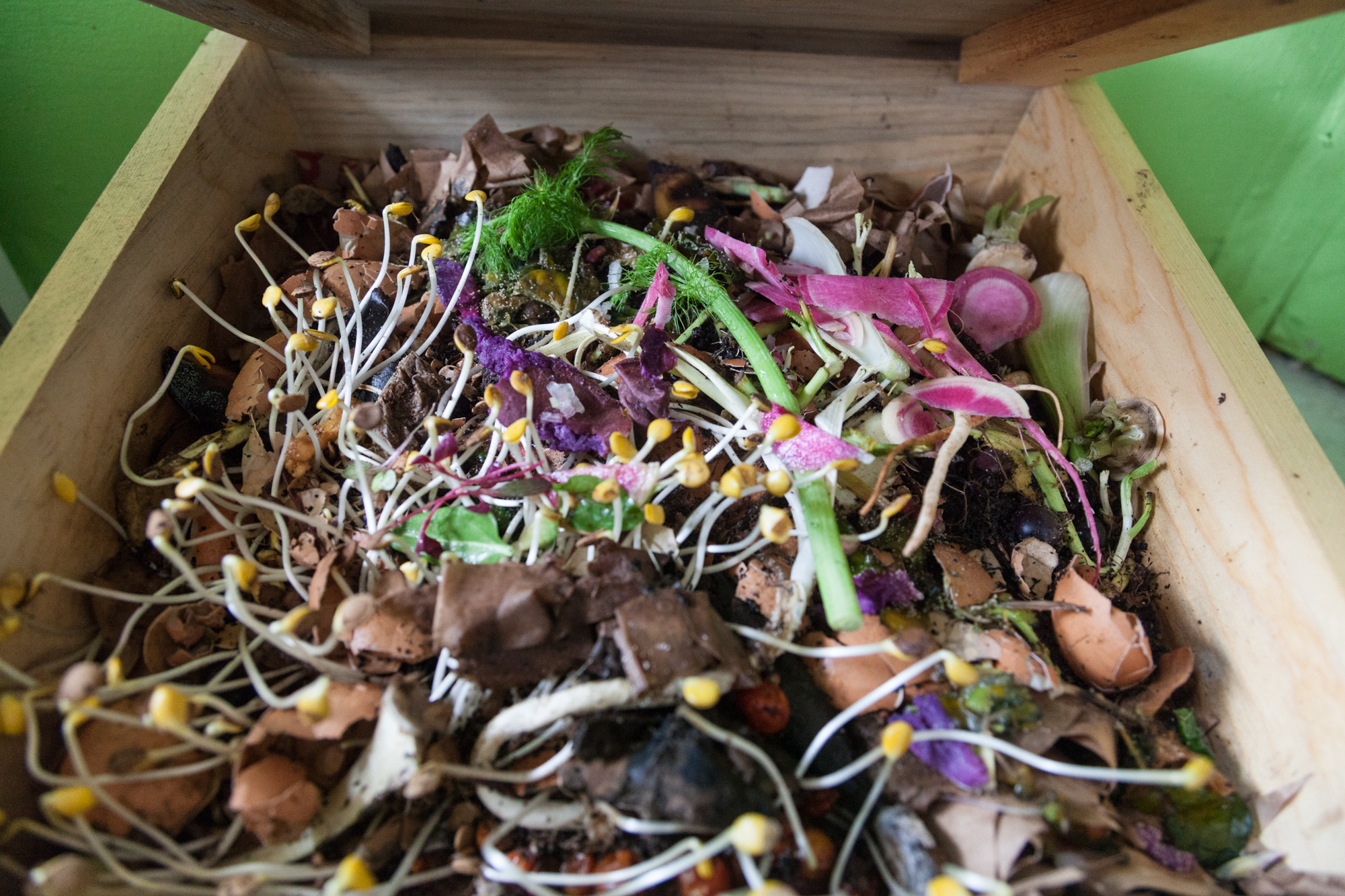Growing up in Northeastern Pennsylvania, composting was just a thing we naturally did. Why would we ever throw away food scraps when they could be turned into beautiful, rich, black soil for our garden? We had a humongous pile of it, buttressed up against our stone wall.
You'd think a pile of food waste, horse poop, and grass clippings would be the deadest pile of crap, but it's quite the opposite. Our compost was its own microcosm—a veritable thing alive! It would steam in the cooler weather and often melt the surrounding snow in winter. Heat emanating from the compost is a byproduct of all the microbial activity digesting the organic material.
Sometimes I'd join my mother or father, looking on as they turned the pile with their shovel. There would be worms and insects a'plenty. And I'd be quick to point out all sorts of weeds and seeds that had taken root in the rich compost.
I didn't start composting right when I moved to New York City, partially because I moved in with a roommate, and I didn't think it would be something she'd go for. After my roommate moved out, I started to take my compost to the farmers market on Saturdays, but it was infrequent on my part.
It wasn't really until about four years ago that I finally got into a rhythm of composting regularly. Two years after that I began vermicomposting in my apartment, which is the use of worms to compost food waste into worm poop or worm castings, as they are euphemistically called. These castings are super rich, and my interest in vermicomposting is not only the worms, (which I think are absolutely adorable), but also to be able to 1.) use the nutrient-rich soil for my plants and 2.) make an all natural fertilizer from the vermicompost.
That rich black soil that you see is actually worm poop! Red wigglers, which are a type of composting worm, digest decaying plant matter and turn it into nutrient-rich "soil" out their other end.
I had always been interested in vermicomposting. One of my first gigs out of high school was working with the Lackawanna County Conservation District in Northeastern PA with the director Ernie Keller, who is big into worm composting. I met him through our high school Envirothon, which is a terrific environmental competition for students, and he often had worm composting displays set up. I remember even one of our team members, Rich, ate a worm from the worm bin in front of the other high schoolers as sort of an intimidation factor...hahaha. Poor little worm. I do think the vermisacrifice worked because we won that year. :)
When considering vermicomposting for my home, there were some considerations I wanted to take into account. Firstly, the bin had to function properly for the worms. Secondly, it had to be convenient to get to, open and close; and thirdly I wanted it to look aesthetically-pleasing, especially since it'd be out in the open under my kitchen sink. There were a lot of DIY specifications online, but almost all of them were for either outdoor use or employed those ugly plastic clothing bins, which I'm not particularly fond of. I looked around for one that was potentially made from wood and I found this one from Sacred Resource, which I absolutely love, and I personally think is the best model out there. They didn't have specs online on how to build their unit, and I couldn't figure it out from looking at the photos, so I posted the how to here for those that are keen on doing this yourself.
Worms that compost
I'll also go over the 10 Steps to Setting Up Your Worm Bin, but here are some important quick facts. The type of worms that you'll need to get for your worm bin are aptly named "red wigglers" (Eisenia fetida). Apt because they are both red and they wiggle. They are not the big, fat night crawlers that you can often find outside, which brings me to my next point. Don't bother collecting your own worms. Just get them from a designated worm grower; I got mine from Uncle Jim's Worm Farm. If you're freaked out about mailing live creatures for whatever reason (mailing does stress them out a bit), then you can likely find someone in your area that can provide you with composting worms. For instance, in New York you can also get them from the Lower East Side Ecology Center, which I've tried to do on two separate occasions but the first time they forgot about my worms and the second time they didn't have them in stock. Additionally, places like Common Ground Compost, may know where to get them locally as well.
Worms eat, but not as much as you do
Secondly, this may be obvious, but if you get 1-2 pounds of worms, which is about 1000-2000 worms, they will eat far less than you can. Worms, once they are established, can eat up to around 50% of their body weight daily, but in the winter months they start to slow down. Since I cook a lot and eat a lot of fruits and veggies, my worms cannot keep up with me, so that means I still compost outside of my vermicomposter. If you put too much food in your vermicomposter, then it can start to smell. If you're putting in just the right amount of food waste, however, then you'll have no bad odors whatsoever.
What worms eat
Thirdly you should know what can be put into a worm bin. Steer clear of citrus fruits! This is one of the biggest mistakes that I see people make. Citrus fruits not only attract fruit flies, but there is also a particular chemical substance in citrus called limonene, which is toxic to worms. Additionally, don't add any meat, including poultry and fish, or dairy. Junk food, candy, oils, baked goods should never be fed to your worms. And also don't bother putting in any big, hard seeds, like the pit of an avocado. That won't harm your worms, but I figure that it will just take too long for the bacteria and worms to break down the big seeds, unless you take the time to mash it down. Basically stick with non-citrusy fruits and veggies, including berries, bananas, melons, stonefruit, beans, carrots, cucumbers, squash; non-sugary cereals and grains; crushed eggs shells; biodegradable tea bags; flowers; leaves; uncoated newspaper; brown bags cardboard, and paper egg cartons. If you're a coffee drinker, coffee grounds are fine to use, but if you use too may of them, it can make the soil environment too acidic for the worms.
Ideal worm environment
Worms require a moist environment and a temperature between 59 and 77 ° F. If it gets too hot, the worms can die, and if the environment starts to dry out, you may find the worms either trying to escape or clumping up to keep moist. Worms that are stressed or afraid, will often clump together. However, if your worms are moving about freely in your worm bin, then you'll know they are happy. I'll touch upon this more in 10 Steps to Setting Up Your Worm Bin, but you'll want to give your worms adequate bedding to start, with for me was a little bit of potting soil and lots and lots of shred-up wet brown paper bags. That will keep them in the worm bin, because occasionally, if you've just put worms in a new home, they will often try to leave the worm bin, particularly if you don't have the proper conditions set up. 🌿
My vermicomposter under my sink: Worms will double their numbers about every three months and can eat up to 50% of their body weight per day. The worm castings are perfect for potting soil for my plants, and you can also make a compost tea from the worm castings, which act as a natural fertilizer. Photo: 6sqft



